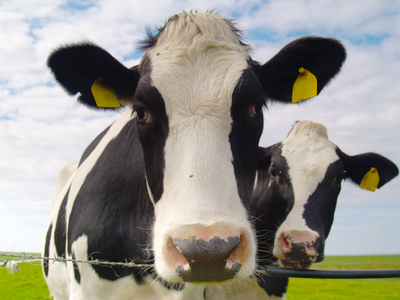Those who are new to this list may not follow my joke: I Told ‘Em! is one of those stories where I was saying it over 30 years ago and is has just recently been “discovered”! Often I was scolded or derided at the time–and then science came around to prove that what I was saying is true–and was true, all along.
This time we are back to how bad milk is for us humans: yes, even raw milk, which many folks can’t get their head round. They just LOVE the raw milk propaganda and cannot be swayed by mere facts.
In this instance, I have pointed out in just about every book I wrote since 1985 that milk causes osteoporosis. It’s simple, if you ask the right questions: US women have the highest intake of dairy produce in the world; they also have the highest rate of hip fractures (more women die of fracture of the neck of femur than die of breast cancer!) Chinese women do not drink milk and the disease osteoporosis is virtually unknown.
The sad truth is that milk actually causes malabsorption. It LOWERS calcium levels and leads to osteoporosis.
 Forget the calcium myth: as I’ve joked for 40 years, if that worked then you could cure iron-deficiency anemia by having people just lick screws and nails!
Forget the calcium myth: as I’ve joked for 40 years, if that worked then you could cure iron-deficiency anemia by having people just lick screws and nails!
Calcium in your mouth does NOT equal calcium in the blood. It just isn’t bio-available.
Milk is so toxic to humans (I’m talking about cow’s; not goat’s or breast milk) that it corrupts the gut lining.
Milk is NOT nourishing, milk is anti-nutritional. It’s all a myth, perpetuated by government bodies, out to protect the farmers’ profits by killing you.
Milk is filth! Don’t drink it. Especially never—ever—give it to a child. Children do NOT need cow’s milk to develop strong teeth and bones. They need to AVOID cow’s milk, to develop strong teeth and bones!
REFERENCES: “Consumption of dairy products, particularly at age 20 years, was associated with an increased risk of hip fracture in old age.” (“Case-Control Study of Risk Factors for Hip Fractures in the Elderly”. American Journal of Epidemiology. Vol. 139, No. 5, 1994).
“These data do not support the hypothesis that higher consumption of milk or other food sources of calcium by adult women protects against hip or forearm fractures.” (Feskanich D, Willett WC, Stampfer MJ, Colditz GA. Milk, dietary calcium, and bone fractures in women: a 12-year prospective study. American Journal of Public Health. 1997).
Anyway, go here and download my booklet on Osteoporosis, if you don’t already have it. It’s FREE; so why not? Click here to download it now. (Be sure and right click and choose “Save as” or “Save target as..”)





What about fermented milk products such as yogurt. Are they still bad. What about cheese?
How many people are drinking Milk aand Milk Products. I don’t beleive all of them
have Osteoporosis.
Arjandas – The Prof’ is being typically English and resorting to their national trait for hyper-exaggeration! Add to this his years living in Florida and no wonder, 34 deg and 90% RH x 24/7 x 364, it would addle anyone’s brain.
I agree with him that cows milk is unnecessary for adult human beings – and apparently it does add significant volumes of fat to Western diets in particular – but – if what he appears to claim was true the Dutch, NZers, Australians, Americans and French would all be in wheelchairs by the age of 50 (a careful understatement you’ll note, as is common this side of the Line); not to mention the Masai in Africa who live on the byproducts of cattle (but with very little meat as each cattle-beast represents “wealth”).
What I read into what he is saying is that drinking milk does not contribute to the prevention of osteoporosis as is promoted by the dairy industry. My personal experience (growing up in a dairying region), is that since I’ve given up having milk on my porridge or muesli (not for 40+ years in tea or coffee), my sinus mucus has cleared. Still eat yogurt and cheese, with no deleterious effect.
Prof. does not – and never has – lived in Florida.
We’ve had the Masai silliness before Murray – go look at the raw milk postings.
Their average life expectancy is about 40 years.
I’m not suggesting that milk takes them down; it’s rampant syphilis. But they are not an exemplary healthy populace.
I eat yoghurt and cheese too, BTW. Very different when fermented.
The fact remains that osteoporosis is proportional to milk intake.
Not living in Florida – your gain I suspect – I thought I had read a note about you there. The rest was a gentle tease only.
Could the issue of “milk and osteoporosis” a double one of an excess of consumption and lack of exercise?
A number of Western European nations (draw a line, say, north – south from Hamburg) retain the enzyme that allows them to digest milk into adulthood. Obviously due to the ongoing consumption of dairy products. East of that line this ability fades – the further east the less often it is noted. This enzymatic ability extends to emigrant populations south of the Line – the Cape Dutch, Australians and New Zealanders of Anglo-Celtic-Saxon-Nordic descent etc. Lactose intolerance, at least of the severe form, is quite rare in these populations (my partner being one, she can only tolerate goats milk and little of that). My thinking is that with a long history of the consumption of dairy – osteoporosis would be endemic and have a long recorded history dating back to say the 1200s – e.g., milk was a major food source for the monasteries – people literate enough to comment.
You comment in the PDF that exercise does not appear to benefit post menopausal women – a group in the modern world that generally get less exercise – walking and lifting – than previous generations. My partner’ bone density (at 65), has recently been tested as that of a much younger person. She is and has been a highly active person (farm work) and has not spent a great deal of her life driving a desk. Her lactose intolerance though may have “saved” her from a lifetime consumption of cows’ milk.
Widow’s Stoop, I don’t see much of today – and my great aunts etc (births circa 1870/1890) I can recall none with such. Most lived well into their 80s and it would have been noticeable. However all regularly consumed milk and all were subject to hard work and pretty active lives. Likewise in my parents’ generation (circa 1910 – 1920). Small cohorts of course, understood, but it was not a feature of people here, for it was so rare that we would comment on it as kids, if seen.
Your comments on the general standard of nutrition in our rushed, packaged and inactive world I agree with wholeheartedly – and just query whether this osteoporosis is not just an amalgam of all the negative factors – making milk just an added one?
Comments are closed.